|
It was Wednesday and
I decided that I had to head up to Pitt Meadows and see if I could
find the handful of Greater White-fronted Geese that was being
seen up there. I'd seen a single White-fronted once before, at
great distance through my binoculars. I only know it was White-fronted
because the birders I was with told me so. So I wanted to see
and recognize these guys for myself, and hopefully get some photos
of them.
I arrived at the location,
a field near Pickett's Nursery, which is on Neaves Road. A quick
scan with the binoculars revealed no White-fronteds, so I picked
up my spotting scope and took it with me as I walked down a dyke.
About a hundred meters or so down the dyke, I set up the scope
and had a look at a flock of (mainly Canada) geese to my south.
After a few minutes of this, I picked up a few smaller geese mixed
in with the big Canadas. They were the Greater White-fronted Geese
that I was looking for. There were seven or eight of them.
I took a few photos,
but quickly realized that the birds were so far away that they
would appear as small blobs in my photo. What I needed was either
to get much closer to the geese, or to get a more powerful optical
setup on my camera. The former didn't seem doable as the geese
were in a private field, so I went for the latter. The only thing
I can do to my standard camera optics is to add a teleconverter,
so I went back to the car for one. This also meant that I needed
a tripod (otherwise the photos would turn out too blurry) so I
carted a second tripod (my scope was on the first) out along the
dyke, put the teleconverter on my camera, and took a bunch of
photos. The geese still came out relatively small, but at least
they're twice as big as they would've been otherwise.
|
|
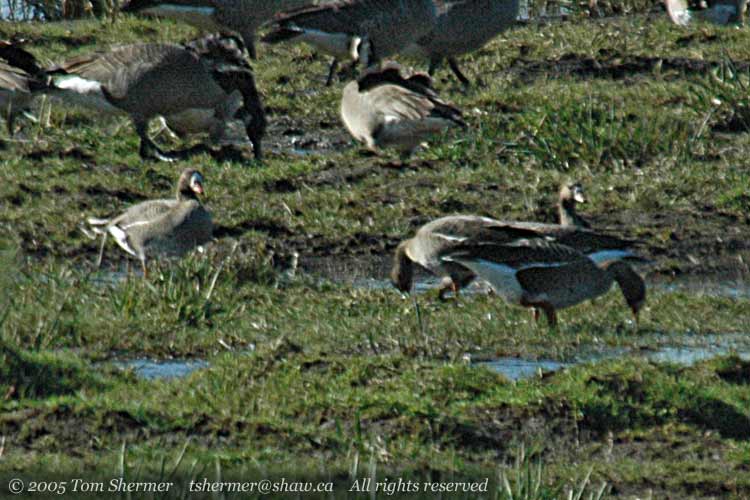 |
|
"Front" in
the name of the Greater White-fronted refers to the front patch
of face, right where the bill attaches. As you can see in the
photo (most clearly on the goose in the middle left), these geese
do in fact have a white front. Most of my photos of them ended
up feeling about the same as this one, so I'm not including any
of the others.
After toting all my
gear back to the car, I headed up Neaves towards Grant Narrows,
and stopped at a trailhead. From there I walked over to the dyke
on the Pitt River, where I caught this shimmering view.
|
|
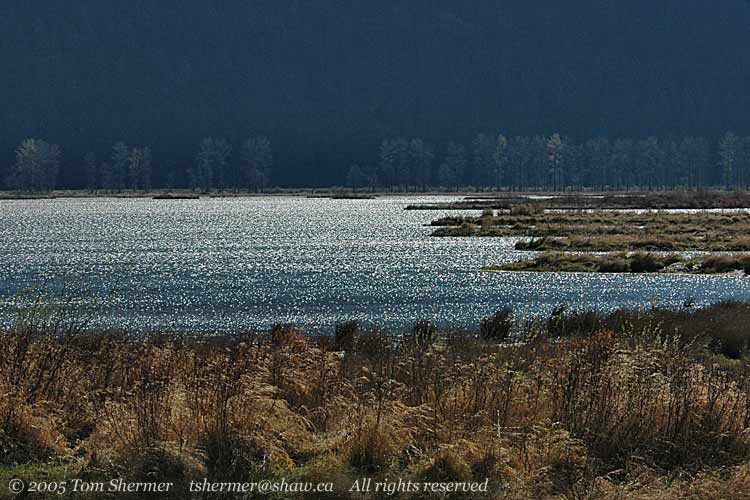 |
| The dyke
was only a short walk from the car, shorter than I had walked to
see the geese earlier. On the way back, in a little side channel,
there were a pair of Ring-necked Ducks. |
|
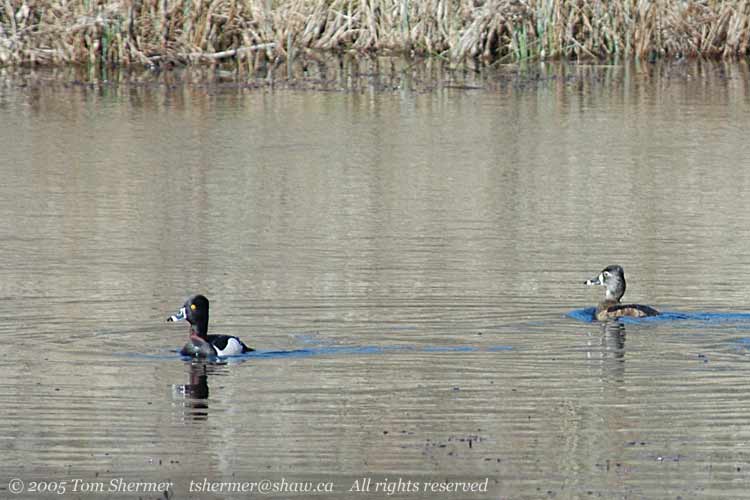 |
| On the other
side of Neaves (or perhaps the road is called Rannie here—it
changes name somewhere in this vicinity) was a trail that I had
never walked before, so I went out on it. It seemed to consist of
a low dyke with water on both sides. Here's a shot along the trail. |
|
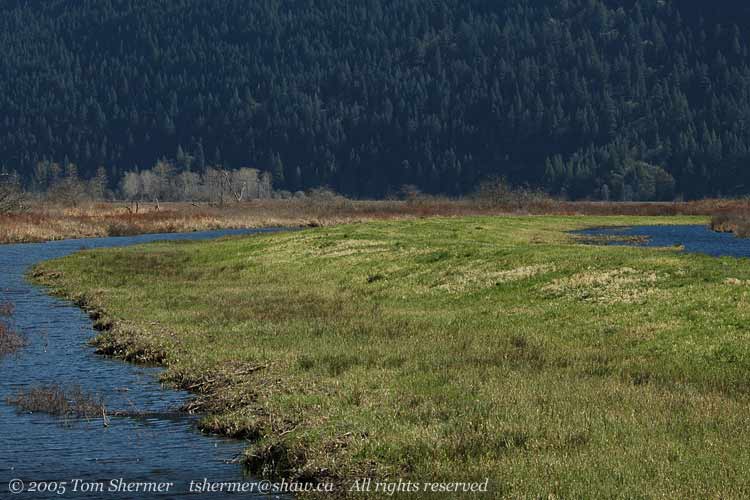 |
| I proceeded
out this trail for a ways, but didn't come across very much bird
life. It was almost midday, so I wasn't that surprised with that.
There was a male Common Merganser in the water on my right, and
as I walked along he kept swimming in the same direction so as to
keep a fair distance between us. |
|
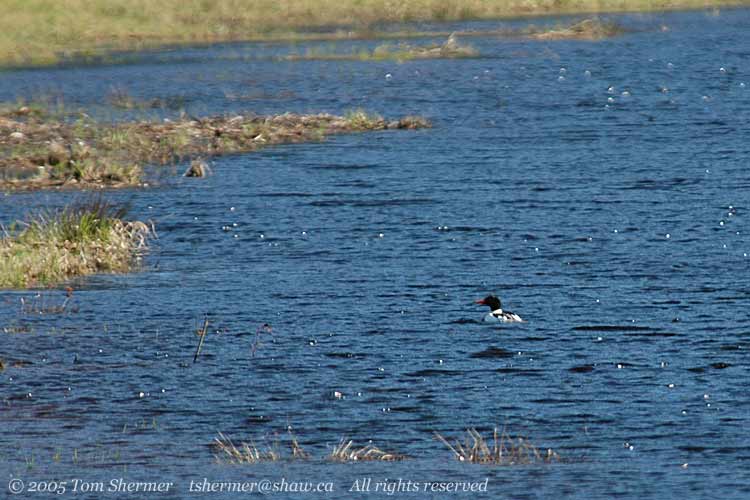 |
| There were
American Robins all along the side of the trail, where it met the
water. Here's one of them, in a very alert and somewhat aggressive
pose. Typically, when a bird is standing or perched and holds their
wings below their tail, it's a defensive, aggressive, or territorial
display. |
|
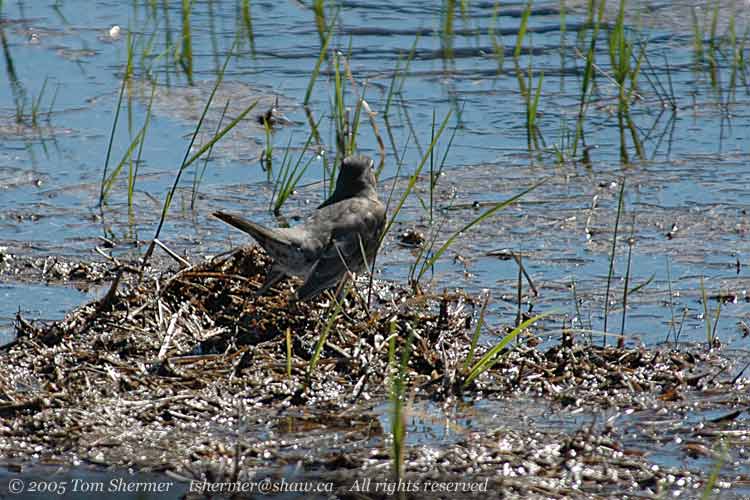 |
| The trail
seemed to go on for quite some distance, and I wasn't in for a long
walk with few birds in the hot sun, so I turned back towards my
car. On the way, I found this male Common Goldeneye just to the
north of the trail. |
|
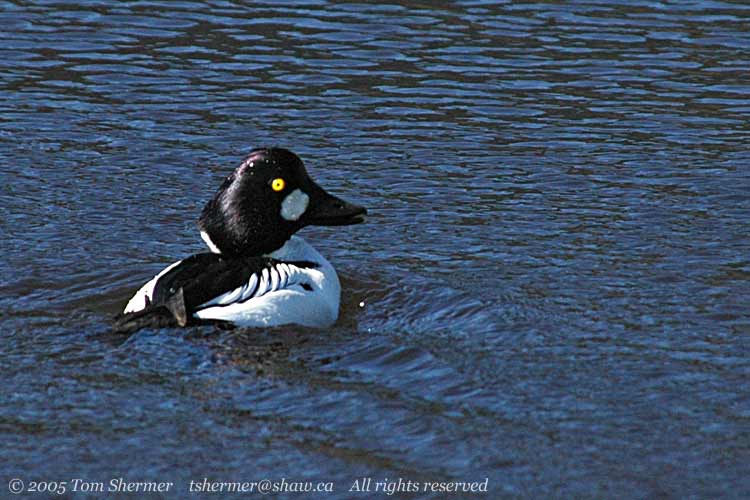 |
| He took
off, and circled a little bit, and I was able to get a shot of him
in flight. It's not the sharpest photo, but it still has a lot of
detail. |
|
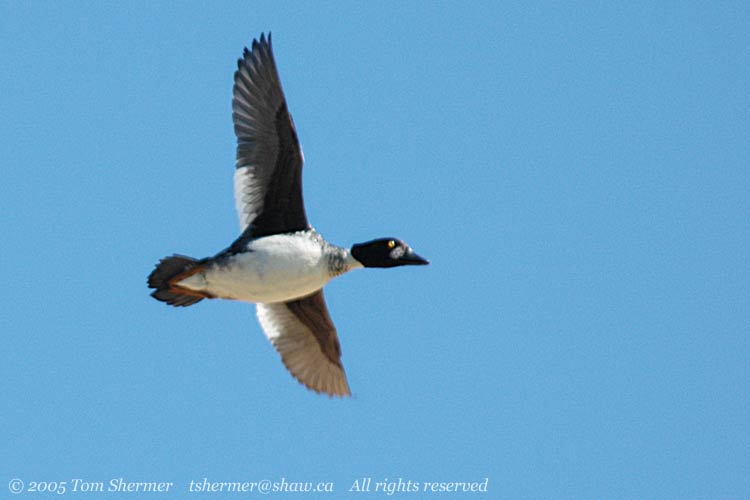 |
| Back at
the car, I decided to not go to Grant Narrows, and instead
drove around the neighborhood in search of roadside subjects. I
found a few, including this charming cudchewer. |
|
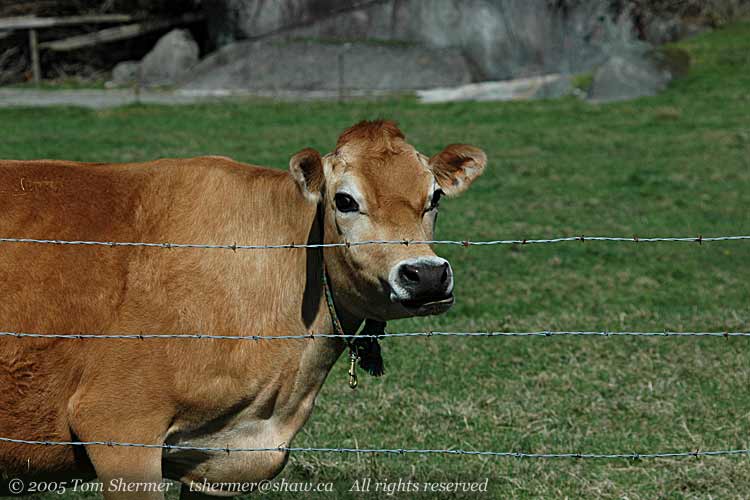 |
| I eventually
stopped at a little town park beside the Alouette River. There I
was able to find a way down to a little clump of land that stuck
out into a widening of the river that could almost be called a pond.
I laid down at the edge of this land, pushed a bit of tall grass
out of the way, and had myself a spot where I could get some photos
of the local ducks without them seeing me, or at least without them
seeing enough of me to scare them. I got a few good photos, like
this female Common Merganser. |
|
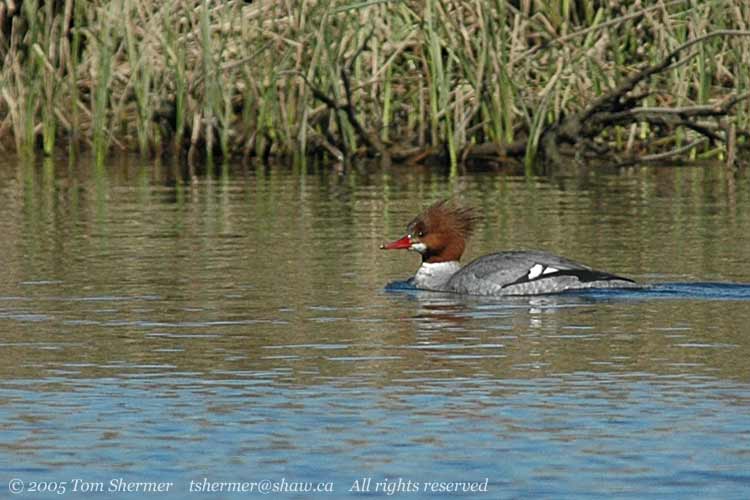 |
| And her
boyfriend, following a ways behind. |
|
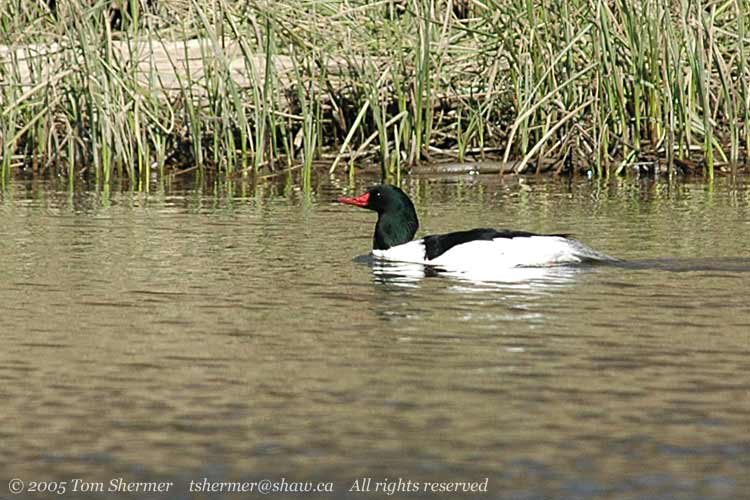 |
| I had a
female Bufflehead come up and have a look at me and the camera. |
|
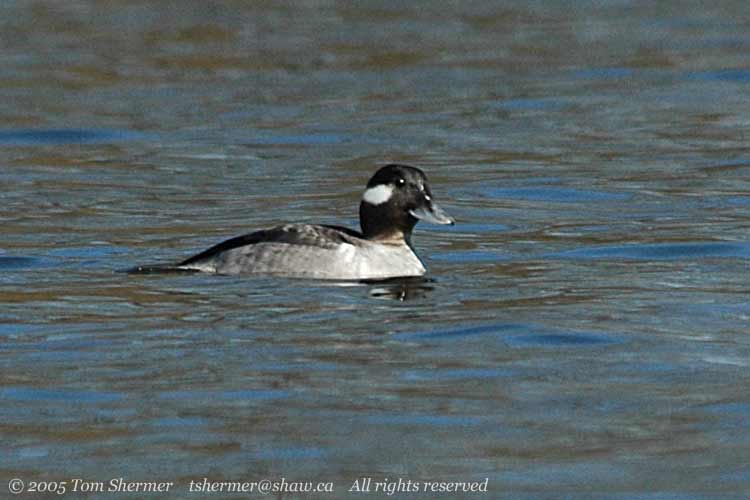 |
| And here's
a male Lesser Scaup who got fairly close. |
|
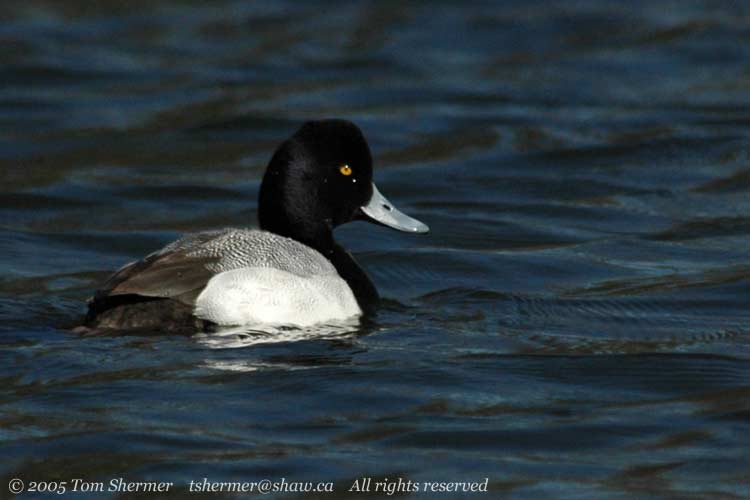 |
| The scaup
were interesting. At one point, I saw an all-male group (about eight
or nine of 'em) floating around, and at other times, they hung out
in mixed-sex groups, like this one. The brownish ducks with the
white fronts are the female scaups. |
|
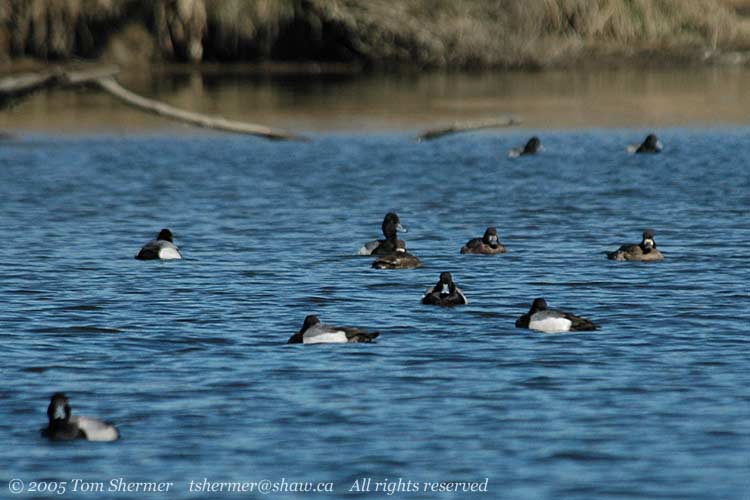 |
|
After fifteen minutes
or so, I got up from my position, happy to be bringing some good
new photos with me. It was only a little later that I noticed
I was also bringing some dirt, some grass, and a few assorted
insects with me. Thankfully, I did notice before I got in the
car.
Once in the car, I
headed across the Pitt River Bridge to Port Coquitlam, in the
general direction of home. But as I drove I decided that I would
like to do a little more photography, so I changed my destination
to Como Lake.
My first subject at
the lake was a beautiful little Ruby-crowned Kinglet. Here's two
shots of him, back and front.
|
|
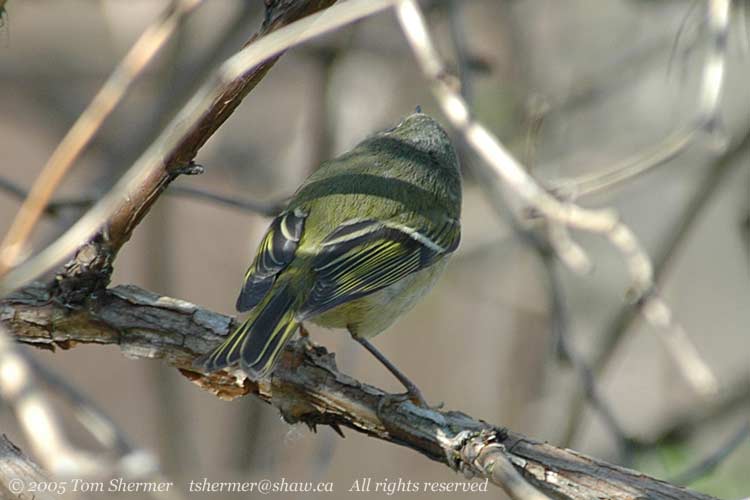 |
| |
|
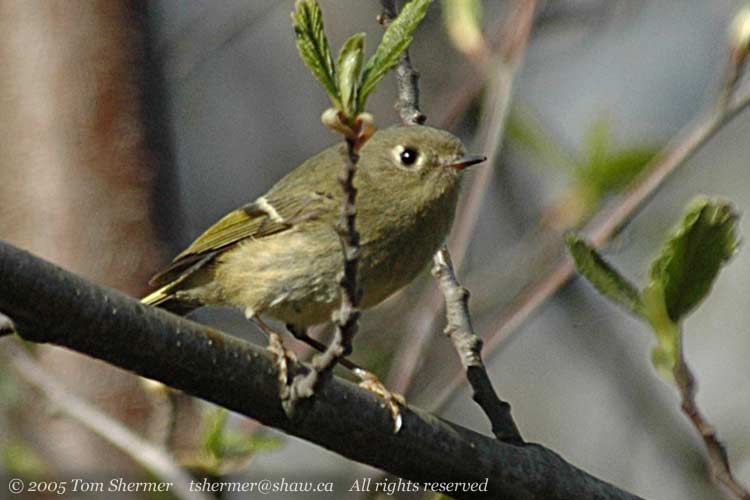 |
|
I walked a little around
the lake and came upon a Northwestern Crow that had really good
lighting on him. Normally, when I see crows or take their photos,
I just see mainly a big black blob in the general shape of a bird.
But on this crow, the details of the feathers and the features
of his face were clearly visible. So I took several photos of
him; happily, the camera picked up the same detail that my eyes
did.
|
|
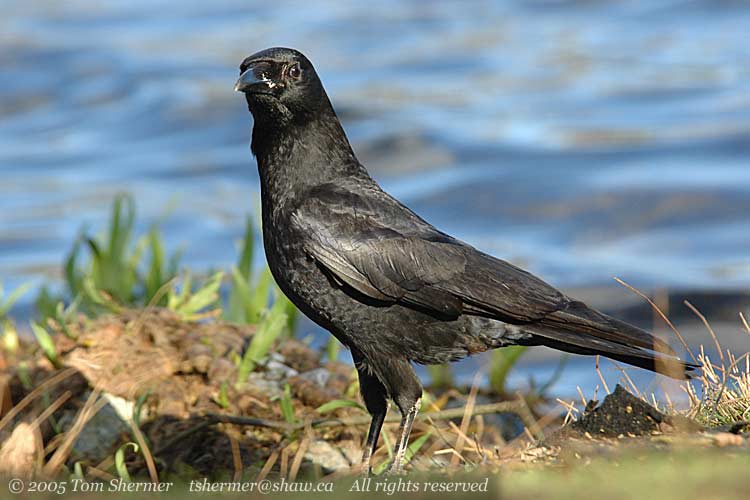 |
| I was over
by one of the little fishing piers when I saw a familiar duck. I
think this duck is a domestic Muscovy duck, or a cross between a
domestic Muscovy and something else, but I'm not sure. None of my
birding friends are familiar enough with the species to definitively
say, either. The people who really know about domestic Muscovies
are bird breeders and bird farmers, and I haven't ever met any of
them (yet). |
|
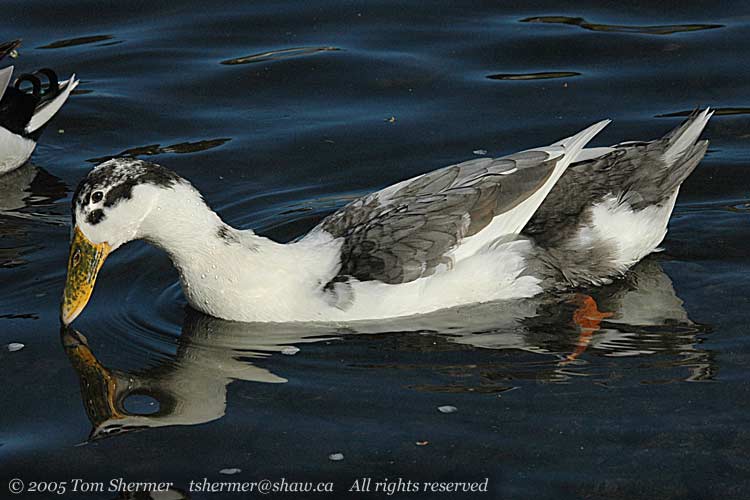 |
| The duck
was bigger than a Mallard, but not the size of a goose. I've seen
him hanging around the lake all this year. Here's a shot of him
face-to-face with a Mallard. |
|
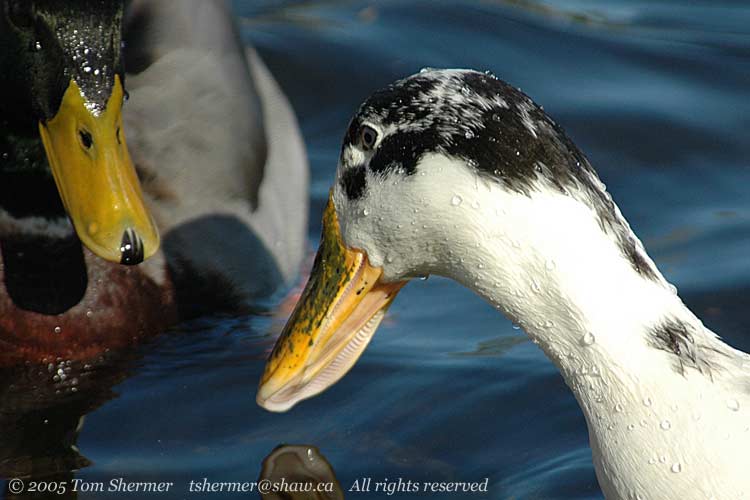 |
| And here's
a detail of the previous photo, showing the structure of his bill.
The little ridges are called lamellae and they help the duck filter
food out of the water. They're a common feature on dabbling ducks,
like the Mallard and the Northern Shoveler. |
|
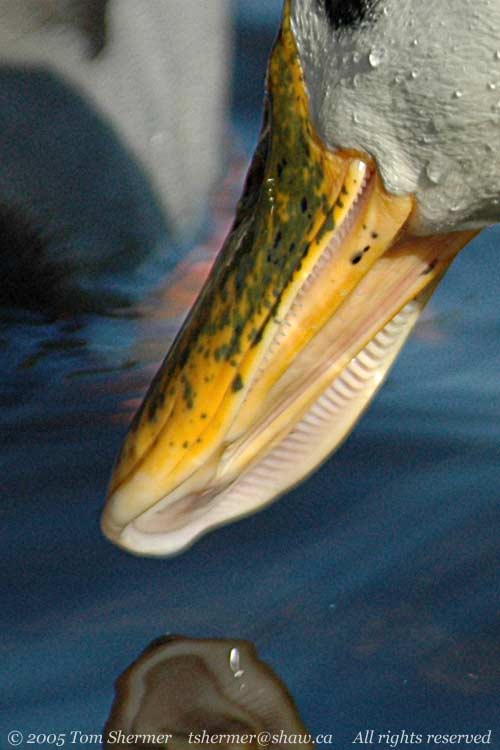 |
| And here's
a final photo of this dashing duck, a head shot. |
|
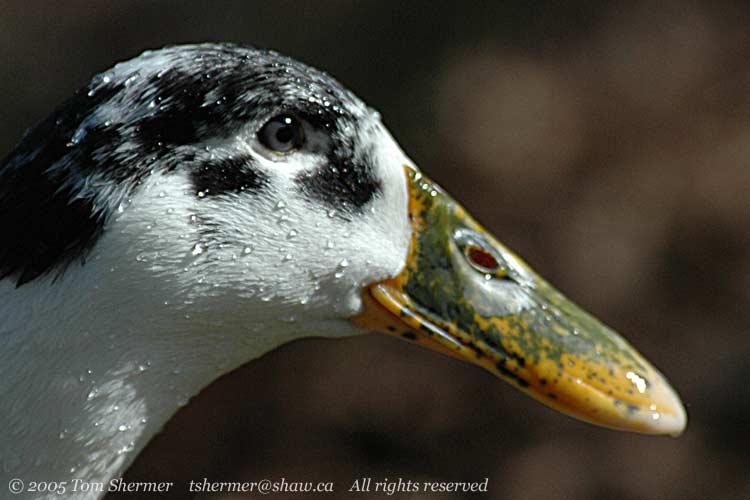 |
|
For comparison, here's
a duck that is definitely a male domestic Muscovy duck. I think
this is the younger duck's father; the black-and-white plumage
pattern on them is very similar. What looks different to me is
the obvious lack of the red mask on the young duck, and the bill
shape, which is rounder on the young duck and sharper on the old.
|
|
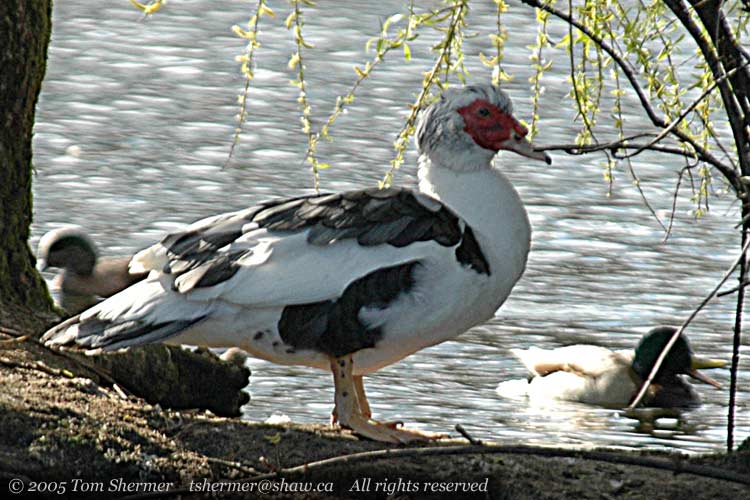 |
|
So if this guy is the
father, the question becomes "who is the mother?" There
was a female domestic Muscovy (or at least, what I think was one)
at the lake a few years ago, but I haven't seen her this year.
Personally, based on bill shape, I'd guess it's the mother was
a Mallard, making the youngster a Muscovy / Mallard cross.
Lord knows, there are
plenty of Mallards at the lake. Here's one of them, a male, who
is drying off after taking a bit of a bath.
|
|
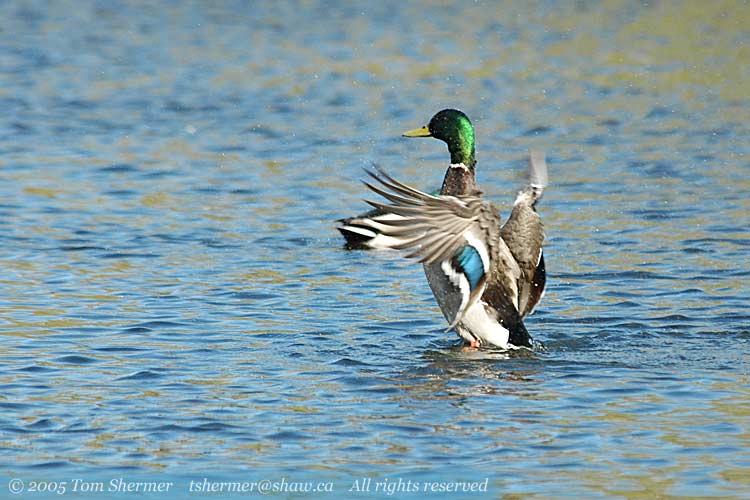 |
| Some of
the trees around the lake were blooming. Spring is a great season
for trees...I really like the different colors that trees can take
on when they're in bloom. |
|
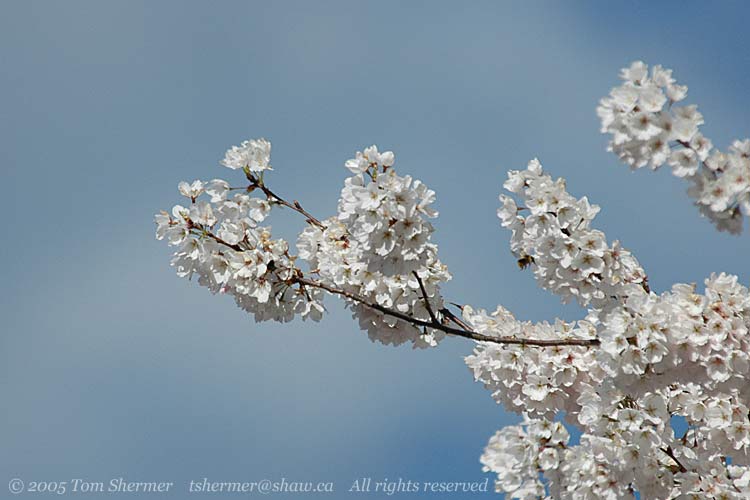 |
|
I went once around
the lake and then headed on home. At home, I was still feeling
up for a bit more outdoors time, so I walked a ways down the quay.
A short ways from my
place on the quay is a little bridge with a lagoon (or "cement
pond", as Jethro would say) on the land side and a small
patch of wetland on the river side. The wetland was a bit dry
today, and one of the cats from my building was down there poking
around. She looked back at me when I called her.
|
|
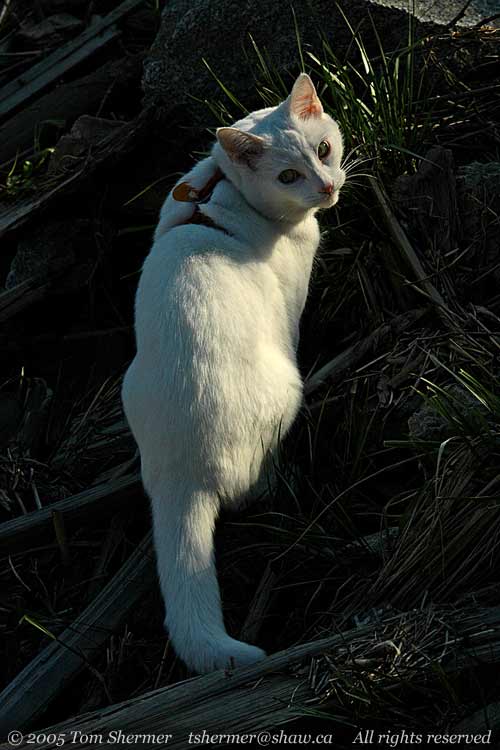 |
|
Futher down, by the
rail bridge, I found a Double-crested Cormorant standing on a
deadhead or something else poking out of the water. One doesn't
often see cormorants hanging around the quay, so I took some photos
of him.
|
|
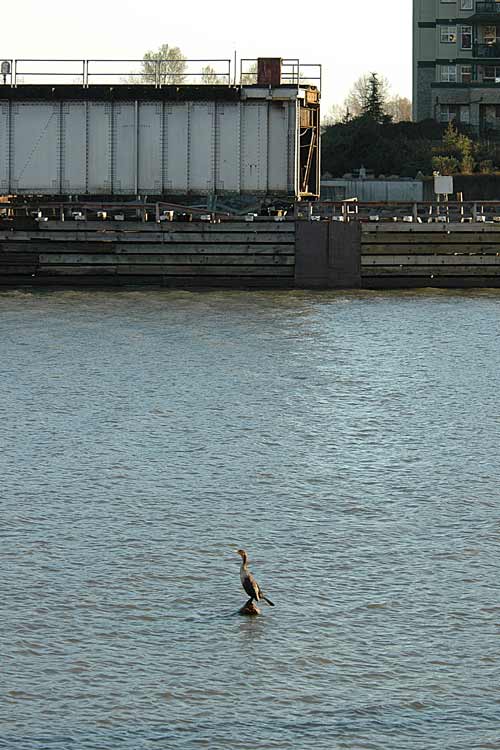 |
|
It was early in the
season, so not much was blooming in the flower beds along the
walkway. About the only things that were out were the daffodils.
Here I've caught one just as the sun is setting on it.
|
|
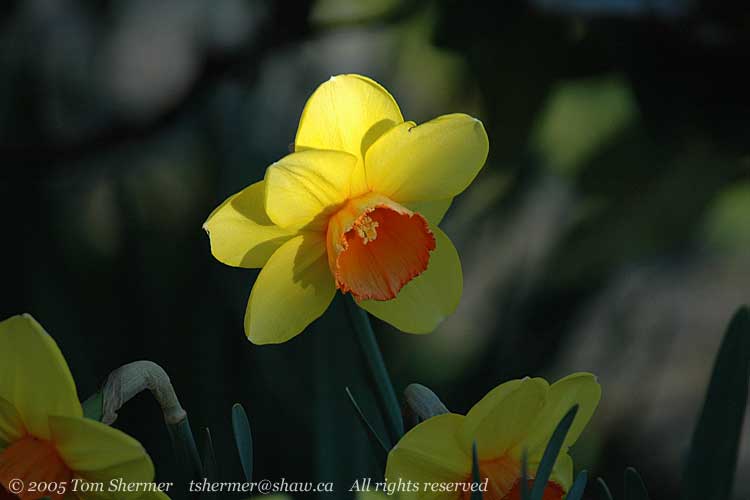 |
|
With the sun truly
waving bye-bye, I headed back home. There I was greeted with a
big yawn and stretch by my pal Sonic. It was nice to see such
enthusiasm.
|
|
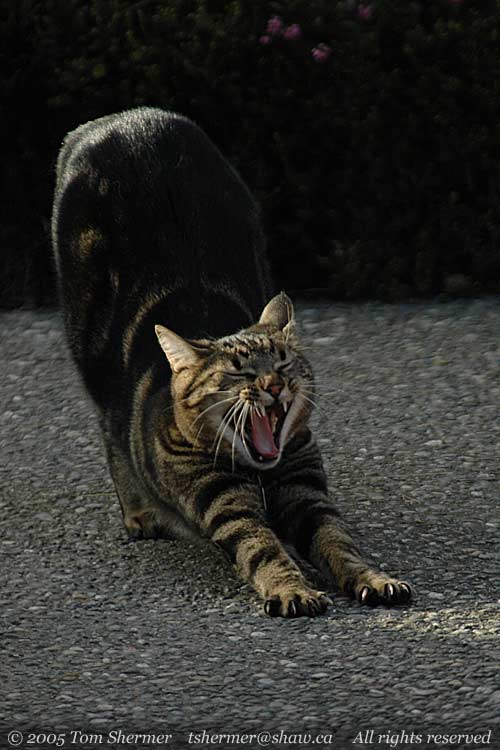 |
|
Actually, Sonic's lethargic
and indifferent ways make him an easier photo subject than my
own kitty, Zippy. When I sit down to take a photo of Zippy, he
comes right over to me—typically too close for me to be able
to focus on him. When I do the same with Sonic, he takes his time
to come visit, and I can get interesting photos of him on the
way.
The man over there
with a look of surprise,
Tom
|
|